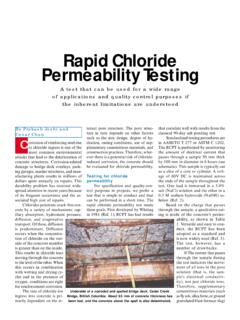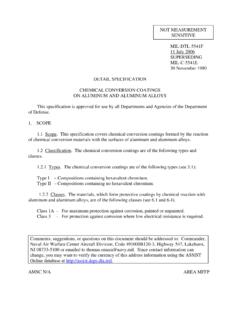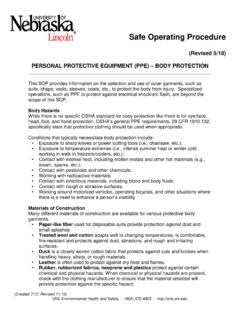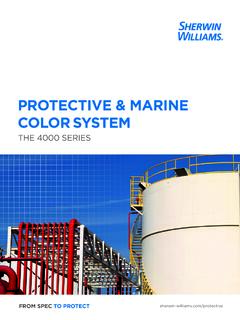Transcription of Effects of Substances on Concrete and Guide to Protective ...
1 IntroductionPortland cement Concrete is durable in most natural environments;however, Concrete is sometimes used in areas where it is exposed tosubstances that can attack and deteriorate it. This publicationdiscusses the Effects of many Substances on Concrete and providesguidelines to Protective first line of defense against chemical attack is to use qualityconcrete with maximum chemical resistance. This is enhanced by theapplication of Protective treatments in severe environments to keepcorrosive Substances from contacting the Concrete or to improve thechemical resistance of the Concrete surface. Protective surface treat-ments are not infallible, as they can deteriorate or be damagedduring or after construction, leaving the durability of the concreteelement up to the chemical resistance of the Concrete maintenance including regularly scheduled cleaning orsweeping, and immediate removal of spilled materials is a simpleway to maximize the useful service life of both coated and uncoatedconcrete the Chemical Resistance ofConcreteQuality Concrete must be assumed in any discussion on howvarious Substances affect Concrete .
2 In general, achievement ofadequate strength and sufficiently low permeability to withstandmany exposures requires proper proportioning, placing, and principles and special techniques that improve thechemical resistance of Concrete follow. Refer to Design andControl of Concrete Mixtures(Kosmatka et al. 2002) for further of Substances on Concrete andGuide to Protective TreatmentsCONCRETE TECHNOLOGYby Beatrix KerkhoffFig. 1. Aggressive Substances can compromise the durability of Concrete . Shown are Concrete beams exposed to high-concentration sulfatesoils/solutions. (PCA/CALTRANS test plot, Sacramento, California) (Stark 2002) (IMG12296)Low water-cement ratio (w/c) the water-cement ratio or thewater-cementitious materials ratio (where applicable) should notexceed by weight ( for corrosion protection of embeddedmetal in reinforced Concrete ). Water-cement ratios for severe chemical exposures often range from to to maximizechemical content at least 335 kg/m3(564 lb/yd3) of cemen titiousmaterial should be used for Concrete exposed to severe freeze-thaw,deicer, and sulfate cement type cement should be suited to the exposure,such as sulfate-resistant cement to help prevent sulfate attack(Table 1).
3 Sulfate-resistant cements, however, like other portland orblended hydraulic cements, are not resistant to most acids or otherhighly corrosive aggregate quality aggregate is not prone to freeze-thaw deterioration or chemical attack. If an aggregate is shown byfield performance (history) or by testing to be susceptible to alkali-aggregate reaction (AAR), appropriate measures should be taken todesign a Concrete mixture to minimize its susceptibility to AAR. (SeeFarny and Kerkhoff 2007 and PCA 2007 for further guidance.) Someaggregates may be more suitable than others for certain chemicalexposures. (See Acids under Design Considerations. )Suitable water mixing water should not contain impurities thatcan impair basic Concrete properties or reduce chemical (1960), and Abrams (1920 and 1924) discuss the Effects ofimpure mixing admixtures (optional) dosage varies to achievedesired reduction in permeability and to improve chemical reducers (ASTM C494) and superplasticizers (ASTM C1017)can be used to reduce the water-cement ratio, resulting in reducedpermeability and less absorption of corrosive chemicals.
4 Polymeradmixtures, such as styrene-butadiene latex, used in the productionof polymer-modified Concrete , greatly reduce the permeability ofconcrete to many corrosive chemicals. A typical dosage of latexadmixture would be about 15% latex solids by weight of integral water-repelling admixtures, also called hydrophobicpore-blocking or dampproofing admixtures, can slightly improve thechemical resistance of Concrete to certain chemicals such as formicacid (Aldred 1988). However, many integral water-repellents offerlittle to no improvement; therefore tests should be performed todetermine the effectiveness of particular admixtures. (See Evaluatingthe Effectiveness of Concrete Surface Protection by Testing. )Admixtures containing chloride should not be used for reinforcedconcrete. Corrosion inhibitors (ASTM C1582) reduce chloride-inducedsteel corrosion. (See Corrosion of Reinforcement under DesignConsiderations.)
5 Alkali-silica reactivity inhibitors, such as lithiumnitrate, can be considered when potentially reactive aggregate isused and when alkali solutions will be in contact with reducing admixtures can reduce the formation of shrinkagecracks through which aggressive chemicals can penetrate cementitious materials (optional) dosagevaries to improve chemical resistance. Supplementary cementitiousmaterials (SCMs) such as fly ash and metakaolin (ASTM C618), slag2 Sulfate exposureSulfate (SO4) insoil, % by massSulfate (SO4) inwater, ppmCement type*Maximum water-cementitious materialratio, by massASTM C150 ASTM C595 ASTM C1157 NegligibleLess than than 150No special type required Moderate** to to 1500 IIIP(MS),IS(<70)(MS) to to 10,000 VIP(HS)IS(<70)(HS) severeOver 10,000 VIP(HS)IS(<70)(HS) 1. Requirements for Concrete Exposed to Sulfate-Containing Soils and Solutions* Pozzolans and slag that have been determined by testing according to ASTM C1012 or by service record to improve sulfate resistance may also be used.
6 Maximum expansions when usingASTM C1012: Moderate exposure at 6 months; Severe exposure at 6 months or at 12 months; Very Severe exposure at 18 months. Sulfate resistance of individual pozzolans or slags needs to be established by demonstrating a maximum expansion of at 1 year, before a 6 months test duration is acceptable. Refer to ACI 201 (2001) formore guidance.** Includes method: ASTM C1580, Standard Test Method for Water-Soluble Sulfate in : Adapted from Bureau of Reclamation 1981, ACI 201, and ACI 318.(ASTM C989), and especially silica fume (ASTM C1240) can improvechemical resistance by reducing the permeability of the Concrete andby producing additional cementitious compounds. Dosages by mass ofcementitious material often range from 15% to 25% for Class F flyash, 15% to 40% for Class C fly ash, 35% to 50% or more for slag,and 5% to 10% for silica fume.
7 Dosage is usually proportional toseverity of exposure to chemical. Supple mentary cementitious mate-rials may not prevent chemical attack but they can slow it down,significantly in some cases. Supple mentary cementitious materialscan help control alkali-silica reactivity for concretes exposed to high-alkali, high-pH solutions. Unless pre vious data exist to confirm thebeneficial effect of these materials in specific exposures, testingshould be performed to substantiate improved chemical resistance.(See Evaluating the Effectiveness of Concrete Surface Protection byTesting. )Air entrainment the proper amount of entrained air is dependenton the exposure condition and on maximum aggregate size (Table 2).Air entrainment makes Concrete resistant to freezing and thawingcycles. In addition it improves sulfate and salt resistance, watertight-ness, and workability avoid mixes so harsh and stiff that honey-combing occurs as well as mixes so fluid that excessive water rises tothe surface.
8 If necessary, water reducers and superplasticizers can beused to make mixes more workable (higher slump). Supplementarycementitious materials can increase or decrease the workability offresh Concrete , so appropriate mix adjustments should be mixing mixing should continue until Concrete isuniform, with all materials evenly distributed. Silica fume may requirea longer mixing period to become thoroughly distributed throughouta Concrete maximumaggregate size,mm (in.)Air content, percent*Severeexposure**Moderateexposure ** (3 8)(1 2)(3 4)(1)(11 2) * Project specifications often allow the air content of the delivered Concrete tobe within -1 to +2 percentage points of the table target values.** Severe exposure is an environment in which Concrete is exposed to wetfreeze-thaw condtions, deicers, or other aggressive agents. Moderate exposureis an environment in which Concrete is exposed to freezing but will not becontinually moist, not be exposed to water for long periods before freezing,and not be in contact with deicers or aggressive from Kosmatka et al.
9 (2002) and ACI 2. Target Total Air Content for ConcreteConsolidation Concrete should be properly molded into formsand around reinforcement to eliminate stone pockets, honeycomb,and entrapped slabs should not be finished while bleedwater is on thesurface or, as this will increase the permeability at the surface,decreasing its chemical resistance (and strength). Supplementarycementitious materials or blended cements may affect the bleedingcharacteristics of Concrete . For instance, silica fume mixes tend tobleed very little, and slag or fly ash mixes may bleed longer due toa slower set. Placing Concrete at the proper temperature promotes uniform bleeding and setting characteristics and helps control finishing jointing isolation, contraction, and construction jointsshould be used to control cracking. Contraction joints in slabs onground should be spaced about 24 to 30 times the slab thicknessand 36 times the slab thickness for mixtures with low water contentand large aggregates (19 mm (3 4in.))
10 Or larger). Joints should beproperly sealed with a material capable of enduring the , if used, must be properly placed. Construction methodssuch as the use of heavily reinforced slabs (Farny 2001) or post -tensioned slabs are helpful in reducing the number of joints in areaswhere joints are curing either additional moisture should be suppliedto the Concrete during the early hardening period or the concreteshould be covered with water-retaining materials. In general, curingcompounds should not be used on surfaces that are to receiveprotective surface treatments. If a curing compound is used, it mustbe completely removed before the surface treatment is applied, or itmust be compatible with the surface treatment so as not to impairbond. Concrete should be kept moist and above 10 C (50 F) for thefirst week or until the desired strength is achieved. Longer curingperiods increase resistance to corrosive Substances by increasingstrength and reducing permeability for all Concrete mixtures.











